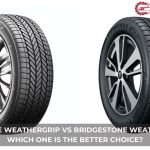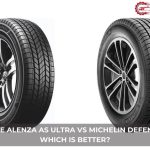When it comes to choosing the right tires for our vehicles, we’re often faced with a myriad of options. Among the top contenders in the tire industry are BFGoodrich and Goodyear, each boasting a legacy of quality, innovation, and performance. But how do we decide which brand is the right fit for our driving needs?
Navigating the world of tires can be a bit overwhelming, but we’re here to help. We’ll dive into the key differences between BFGoodrich and Goodyear tires, considering factors like durability, performance in various conditions, and overall value. Whether you’re hitting the highway, tackling rough terrain, or simply cruising around town, understanding these differences can help us make an informed decision.
So, let’s get rolling and explore what sets these two tire giants apart. Our journey will not only shed light on their unique offerings but also ensure that we’re well-equipped to choose the best tires for our adventures on the road.
History and Legacy of BFGoodrich and Goodyear
Building on our discussion of the challenge of choosing between BFGoodrich and Goodyear tires, we’ll delve into the rich history and strong legacy that both companies hold in the tire industry. This exploration will further illuminate why these brands have become top contenders, revered for their quality, innovation, and performance.
BFGoodrich, established in 1870 by Dr. Benjamin Franklin Goodrich, boasts a noteworthy legacy as the first American tire manufacturer. The company played a pivotal role in the automotive revolution, producing the first pneumatic automobile tire in the United States in 1896. BFGoodrich’s historical milestones include outfitting Charles Lindbergh’s Spirit of St. Louis with tires for his historic transatlantic flight in 1927 and contributing to the space race by developing tires for the Columbia space shuttle. Their reputation for innovation is matched by their commitment to providing tires that enhance driving performance in various conditions.
Goodyear, founded in 1898 by Frank Seiberling, has equally distinguished itself as a pioneer in the tire industry. Named after Charles Goodyear, the inventor who discovered the rubber vulcanization process, Goodyear quickly rose to prominence through its commitment to innovation. The company introduced the first all-season tire in 1977, revolutionizing the industry and setting new standards for tire performance across different weather conditions. Goodyear’s contributions to space exploration, including manufacturing the tires for the Apollo lunar rovers, underscore its legacy of innovation and excellence.
Both BFGoodrich and Goodyear have solidified their statuses as industry leaders, each boasting a rich history of firsts and groundbreaking achievements. Their legacies are built on a foundation of innovation, quality, and performance, offering drivers tires that meet a wide range of needs, from everyday commuting to adventurous off-roading. Understanding the historical context and contributions of these companies adds depth to our comparison, highlighting their dedication to excellence and innovation over the years.
Product Range and Offerings
Building on the innovative legacies of BFGoodrich and Goodyear, we find that their product range and offerings reflect their commitment to quality and performance. Both brands cater to a variety of driving needs, from everyday commuting to professional racing, and everything in between.
BFGoodrich boasts a diverse selection of tires including, but not limited to, all-terrain, mud-terrain, and performance tires. The brand is renowned for its All-Terrain T/A KO2, a favorite among off-road enthusiasts for its durability and traction on any surface. For performance enthusiasts, their g-Force series offers exceptional grip and handling on the track.
Goodyear, on the other hand, offers an extensive lineup that features all-season, winter, performance, and all-terrain tires. They’re particularly well-known for their Assurance family of tires, designed to deliver a smooth, quiet ride with enhanced fuel efficiency for everyday driving. The Wrangler series by Goodyear stands out for its rugged dependability, especially in off-road conditions, while their Eagle lineup caters to drivers seeking high performance and precise handling.
Our exploration of these offerings shows both companies’ dedication to innovation. Goodyear’s Weather Reactive Technology, which adjusts to road conditions for improved safety, and BFGoodrich’s CoreGard Technology™, designed to prevent sidewall splitting and punctures, exemplify their focus on advanced tire solutions.
In examining the product range and offerings, we see that both BFGoodrich and Goodyear go beyond merely manufacturing tires. They offer solutions tailored to consumers’ diverse needs, ensuring reliability, safety, and performance. As we delve deeper into the specifics of their catalogs, it’s clear that their innovations and diverse offerings make both brands formidable choices for any driver.
Performance in Different Conditions
After exploring the rich histories and comprehensive product ranges of both BFGoodrich and Goodyear, let’s dive into how their tires perform under different conditions. This aspect is crucial for drivers seeking reliable tires that can withstand various environments and weather scenarios.
Dry Conditions
In dry conditions, BFGoodrich tires, especially the g-Force series, exhibit excellent grip and handling. Their precise steering and stability make them ideal for performance-oriented driving. Goodyear tires, with options like the Eagle series, also provide superb traction and responsive handling in dry conditions, ensuring a safe and smooth ride for daily commutes and spirited driving alike.
Wet Conditions
When it rains, both brands’ technologies come into play to maintain safety and performance. Goodyear’s Weather Reactive Technology, found in the Assurance series, offers enhanced grip on wet roads, reducing the risk of hydroplaning. Similarly, BFGoodrich’s tires, such as the Advantage T/A series, feature deep grooves and specialized tread designs that effectively channel water away, ensuring reliable wet traction.
Snow and Ice
Winter conditions present a challenging environment for any tire. Goodyear’s winter tires, like the Ultra Grip series, are designed with unique tread patterns and rubber compounds to offer superior traction on snow and ice. BFGoodrich responds to winter challenges with options like the Winter Slalom KSI, providing confident handling and braking in cold, snowy, or icy conditions.
Off-Road Performance
For off-road enthusiasts, BFGoodrich’s All-Terrain T/A KO2 tires stand out with their rugged durability and traction on various terrains, including mud, gravel, and rock. Goodyear’s Wrangler series competes closely, offering robust off-road performance with features that support driving on challenging landscapes.
Both BFGoodrich and Goodyear produce tires that excel in diverse driving conditions. Whether you’re navigating dry highways, wet city streets, snowy paths, or rugged trails, both brands offer dependable options designed to meet the demands of the environment and deliver a secure driving experience.
Durability and Lifespan
In our exploration of BFGoodrich vs Goodyear tires, a critical aspect to consider is their durability and lifespan. Both brands have built reputations for producing long-lasting tires, but there are nuances to each that could influence a consumer’s choice.
Starting with BFGoodrich, this brand is renowned for its rugged, durable tires, particularly in the All-Terrain T/A KO2 series. These tires are designed with CoreGard Technology™, which enhances sidewall strength and resistance to bruising and splitting. Moreover, BFGoodrich tires are favored by off-road enthusiasts for their long wear life, a feature especially important in harsh driving conditions. Users report satisfactory mileage, often exceeding the manufacturers’ warranty.
On the other hand, Goodyear tires boast impressive lifespans as well, backed by their innovative tread compounds and designs. Goodyear’s Assurance series, for instance, uses TredLife Technology, ensuring longer tread wear under a wide range of driving conditions. Additionally, Goodyear provides a comprehensive warranty program that underscores its commitment to tire longevity. Consumers often highlight Goodyear tires for their reliability over many miles of city and highway driving.
In choosing between BFGoodrich and Goodyear in terms of durability and lifespan, it’s crucial for customers to consider their specific driving needs. For those frequently venturing off the beaten path, BFGoodrich offers durability that withstands rough terrain. Meanwhile, Goodyear tires might appeal more to those primarily driving on road, where their advanced tread designs promise extended wear in diverse driving conditions.
Overall, both BFGoodrich and Goodyear tires deliver on the promise of durability and longevity. However, the optimal choice between them hinges on individual driving habits and the specific tire technologies that align with those needs.
Price Comparison
Transitioning from the durability and lifespan discussion, we now shift focus to the price comparison between BFGoodrich and Goodyear tires, a crucial aspect for many consumers. Price plays a significant role in the decision-making process when choosing the right tire brand for your needs.
Analyzing the pricing strategies of BFGoodrich and Goodyear reveals some interesting insights. BFGoodrich tires, renowned for their all-terrain and performance capabilities, often come with a price tag that reflects their targeted niche market. For example, the All-Terrain T/A KO2 series, esteemed for its durability and off-road performance, typically commands a higher price point than standard passenger car tires, reflecting its specialized application and construction.
On the other hand, Goodyear’s pricing varies more widely across its product range. The brand offers a vast selection of tire types, from all-season to performance and winter tires. Entry-level Goodyear tires, like those in the Assurance series, are priced competitively, providing consumers with an affordable option that still incorporates Goodyear’s innovative technologies for durability and performance. Meanwhile, Goodyear’s premium offerings, including some of its winter and performance tires, align with BFGoodrich’s higher-end products in terms of price, catering to consumers seeking superior quality and specific tire features.
In terms of overall value, both BFGoodrich and Goodyear offer options that range from more economical choices for everyday driving to premium tiers for special driving conditions and performance needs. The price difference between similar tire categories from both brands is typically not vast but can vary based on tire size, technology, and seasonal demand.
Ultimately, consumers looking for specialized tires for off-road or performance driving may find BFGoodrich’s prices justified by their quality and durability. Meanwhile, those seeking tires for regular commuting with a balance of performance and affordability might lean towards Goodyear’s offerings. The decision boils down to evaluating the price in conjunction with the tire’s intended use, technology, and the benefits it offers to meet your specific driving requirements.
Environmental Impact and Sustainability Efforts
Delving into the environmental impact and sustainability efforts of BFGoodrich and Goodyear, we find both brands taking significant strides towards reducing their ecological footprints. Understanding that tire manufacturing inherently impacts the environment, these companies have initiated various practices aimed at sustainability and eco-friendliness.
BFGoodrich emphasizes recycling and reducing waste in its production processes. Utilizing advanced manufacturing technologies, the company strives to minimize energy consumption and carbon emissions. BFGoodrich also participates in the development of tires designed to improve fuel efficiency for vehicles, thereby reducing the overall carbon footprint associated with driving.
Goodyear takes sustainability a step further by not only focusing on production efficiency but also pioneering the use of renewable materials. The company has invested in research and development to incorporate bio-based materials into its tire production, such as soybean oil, which replaces petroleum-based oils. Additionally, Goodyear’s tires are designed to last longer, which contributes to less frequent tire changes and, consequently, a reduction in tire waste.
Both companies show a commitment to environmental stewardship through their membership in various sustainability organizations and partnerships with other companies to explore and implement eco-friendly practices across their operations. They recognize the importance of tread life extension, recycling programs, and energy-efficient manufacturing in mitigating the environmental impact of tire production and use.
BFGoodrich and Goodyear both endeavor to lead in the realm of environmental responsibility. Their efforts focus on reducing waste, enhancing fuel economy through tire design, and pioneering the use of sustainable materials. These initiatives demonstrate their dedication to not only meeting the needs of today’s drivers but also protecting the planet for future generations.
Conclusion
Deciding between BFGoodrich and Goodyear isn’t just about choosing tires. It’s about picking a partner for your journey. Whether you’re navigating rough terrains or seeking durability across diverse conditions, both brands offer compelling reasons to drive their way. It boils down to what matters most to you: the specialized ruggedness of BFGoodrich or the versatile endurance of Goodyear. Plus, their strides in sustainability mean you’re not just investing in your ride but also in the planet. So let your driving needs and values steer your choice. After all, the right tires don’t just fit your car; they fit your life.
Related Posts:












